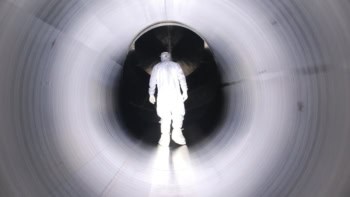Los Alamos National Laboratory, a centre synonymous with nuclear weapons, is trying to forge a new future. Peter Gwynne speaks to John Browne, the new director.
First published November 1997 in Physics World
As the sixth director of the Los Alamos National Laboratory, John Browne faces broad challenges at a critical time in the laboratory’s history. After a lifetime of secrecy – the first atomic weapons were built there in 1945 – public concerns are forcing the lab to become more accountable. But the key challenge for Browne’s directorship will be stockpile stewardship – the task of maintaining the safety and reliability of US nuclear weapons without explosive testing.
The laboratory, in the south-western state of New Mexico, is one of the world’s largest multidisciplinary research centres. With an annual budget of about $1.2 bn, it employs about 6800 people – roughly one-third of whom are physicists – with a further 2800 people working for the laboratory’s contractors. The organization has several science divisions, including physics, nuclear materials technology, applied physics and computational physics, and nuclear weapons technologies programmes. A relatively recent addition is the Los Alamos neutron science centre (LANSCE), a pulsed neutron research institute that includes what used to be the accelerator operations and technology division.
Before taking over from Sig Hecker as director of the lab, Browne was director of LANSCE. He has no doubts about the basis of his directorship of Los Alamos. “One of the things I share with my predecessors is scientific excellence, ” he says. “Being good in science and the quality of the people will really be the key to whether we can create this new future for our success.”
Browne will need to use all his management skill, because Los Alamos faces a period of retrenchment. Certainly, the lab’s budget has increased over the past two years due to the introduction of the stockpile stewardship programme. But the long-term outlook is somewhat pessimistic, according to Robert Park of the American Physical Society. “It’s difficult to rationalize having two nuclear weapons laboratories, ” Park explains, referring to Los Alamos and the Lawrence Livermore National Laboratory in California.
More immediately, Browne also faces problems with the lab’s safety procedures. A series of four apparently unrelated accidents over a period of 16 months, which killed one person and left another in a coma, led Hecker to shut down all work at the lab while all employees reviewed safety procedures. As a result, Los Alamos instituted what it calls integrated safety management, a process that makes every single employee responsible for the lab’s safety, and permits each one to halt work at any time on the basis of perceived danger.
However, says Browne, implementation of integrated safety management needs to improve. “I believe we’re well along the way, but we’re not there yet, ” he says. “I think that one of the major issues we have to deal with is that the lab has been secretive for 50 years, ” Browne says. “The game has changed. We should be able to reduce the amount of waste the laboratory produces; we should try to minimize the amount of emissions we have from our work. I think we need to be as open as we can with the public.” That will not be easy. Representatives of communities around Los Alamos have long complained that the lab has failed to inform its neighbours about either immediate problems such as accidents or its long-term mission.
But the greatest challenge will be stockpile stewardship programme to ensure that nuclear weapons will explode when they are meant to but won’t when they are not. This programme consists of a variety of computational work and research using neutrons, lasers and other large facilities. “Performing the stockpile stewardship management programme is really a grand scientific challenge, ” says Browne. “It’s the one area in modern technological enterprises that will not be using testing as you actually develop a product. It’s going to require good facilities and good people. So recruiting is a major part of this.”
How will Brown attract top-notch young scientists? “One of the reasons that we’ve been able to attract the best and the brightest is the breadth of programmes that we have, ” he explains. “You know that it’s not necessarily the first place a graduate thinks of coming, to work on defence programmes, but many times they’re attracted to work on a problem of great scientific challenge.”
Indeed, Los Alamos offers scientific challenges beyond the near-term concerns of stockpile stewardship. “There are lots of issues we may have to be worrying about down the road; the capabilities we have at this laboratory as a result of our prime mission could be brought to bear on other problems. Global climate change is an example of one where computational modelling plays a major role, ” Browne points out. “There are plenty of other areas in non-defence research where the laboratory has made a contribution in the past and I think we just need to make sure that we don’t forget about the other things that we can do for our country, ” says Browne.



